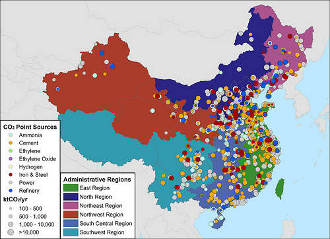Communications of the ACM
Pnnl, Chinese Researchers Begin Cooperative Clean Energy Work
Pacific Northwest National Laboratory is part of a joint U.S.-Chinese team embarking on projects in three separate research areas to accelerate the development and deployment of coal conversion, emissions capture and carbon storage technologies.
Laboratory directors from the Department of Energy's PNNL in Richland, WA, and the National Energy Technology Laboratory (NETL) in Morgantown, WV, met with researchers from the Chinese Academy of Sciences (CAS) in Beijing to kick off the new clean energy technology research effort in June.
The projects are the first activities to come out of a 2009 memorandum of understanding among the three organizations.
"Establishing a strong scientific alignment between U.S. and Chinese researchers is the key to developing and deploying solutions to our collective emissions problem," says PNNL Director Mike Kluse. "We must use our nations' complementary skills, in collaboration, to move discoveries and technologies into the marketplace."
As part of the MOU, the research team, called the Clean Energy Partnership, will perform research projects in three areas.
 A 2009 assessment by PNNL concluded that China has2,300 billion metric tons of potential underground storagefor emissions like carbon dioxide. Credit: Pacific Northwest National Laboratory A 2009 assessment by PNNL concluded that China has2,300 billion metric tons of potential underground storagefor emissions like carbon dioxide. Credit: Pacific Northwest National Laboratory |
Second, scientists and engineers will collaborate on co-gasification of coal and biomass as well as the development of new, higher temperature materials and processes to remove impurities in the emissions stream.
In the final research area, the team will improve the overall efficiency and economics of converting synthetic gas into natural gas using advance computational simulations and through developing new catalyst materials.
PNNL's collaborations with China date back to the early 1990s when it helped found the Beijing Energy Efficiency Center. However, collaborations have become more common in recent years.
In 2006, PNNL joined with the CAS's Dalian Institute of Chemical Physics and its Institute of Coal Chemistry to form the International Consortium for Clean Energy, or ICCE. Supported by an investment from PNNL and with encouragement from CAS President Lu Yongxiang, this mechanism has brought more than 25 senior U.S. and Chinese scientists together to conduct research.
In the course of forming the ICCE, Yongxiang challenged CAS, PNNL and NETL to develop a more extensive effort to address fossil energy conversion and emissions capture and sequestration. As a result, PNNL and NETL directors signed an MOU with the CAS Research Center for Energy and Power in May 2009, with the aim of significantly reducing environmental emissions and improving efficiency of fossil fuel conversion.
Kluse also was in Beijing in May to speak at the International Cooperative Conference on Green Economy and Climate Change. He discussed PNNL's existing collaborative partnerships with Chinese research institutions, and how PNNL is creating solutions for technical challenges in the areas of emissions management, smart grid technologies, energy efficiency technologies and technology transfer.
"The United States and China are the world's two largest economies and face similar challenges with growing energy consumption and its impacts," said Kluse. "We owe it to ourselves and the world to develop and then deploy technology that will significantly reduce industrial emissions."
PNNL scientists are solving complex challenges in energy, including researching the next generation of biofuels, designing smart grid technologies, and helping set building efficiency standards. PNNL also is known for its role in providing data used to establish energy policy, and in integrated climate assessment and climate change research.
No entries found